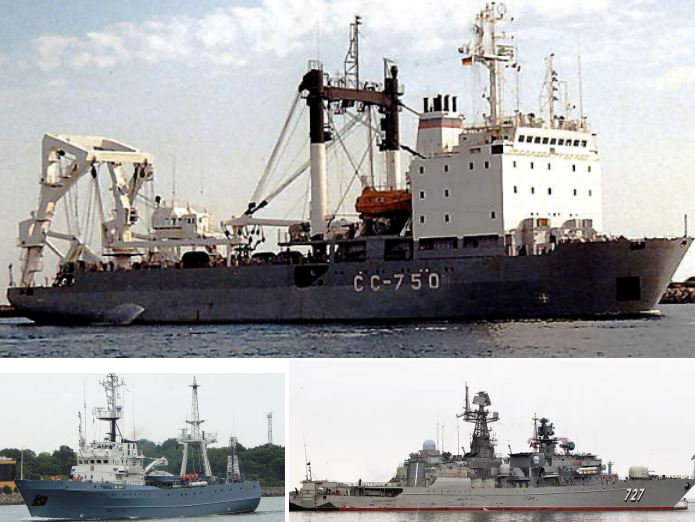

By John Helmer, Moscow
@bears_with [1]
The NATO intelligence publicity department known as Bellingcat has just produced new NATO-sourced evidence of an elaborate cat-and-mouse game which the navies and air forces of Denmark, Sweden, Germany, Poland, and the US played against Russian forces in the Baltic Sea off Bornhom Island in the week before the detonation of explosives on the Nord Stream gas pipelines last September 26.
Cat and mouse is also the game the NATO propaganda agencies are now playing.
The aim of the intelligence, published last week by the quasi-state German media platform called T-Online [2], and in the Danish offshoot of Bellingcat known as Oliver Alexander [3], is to accuse the Russian Navy of the pipeline attack, using a mini-submarine and deep-sea divers. This is based on NATO and US identification and tracking of a six-vessel Russian flotilla several days before the explosions – an intelligence vessel, a deep-sea operations vessel, two tugs, and heavily armed anti-ship and anti-submarine frigate and corvette.
“It was precisely such mini-submarines that could have placed the explosive charges attaching it to the pipelines, experts suspected from the very start,” T-Online claims, using the hypothetical followed by a conditional plus three more hypotheticals.
“If it was confirmed that the SS-750 was at the scene, the Russian Navy would probably be the prime suspect from then on. ‘It would make absolute sense to use something like the AS-26 for such an attack,” Danish corvette captain and military analyst Johannes Riber told T-Online about this matter. ‘That would be the most plausible explanation so far for what happened to the Nord Stream pipeline.’” T-Online concluded: “In official statements, the activities of the Russian navy in the days before the attacks have so far played no role. Neither the German, Danish or Swedish investigators, nor NATO or the armed forces of the Baltic Sea states wanted to comment on them when asked by T-Online. Thus, the criminal case remains unsolved for the time being, but a chain of evidence has been added. It does not point to the USA or Ukraine. Some tracks now are leading to Moscow.”
Riber [4], the Danish navy source, has made a career chain of working in NATO staffs, as well as under US commands in Iraq and Bahrain. In addition, T-Online claims its evidence has come from US satellite imagery and “sources in the security community”.
In parallel publication under his own name, Alexander has been less forensically direct, more circumstantial. The Russian vessels were “possibly… in close proximity to the Nord Stream sabotage site”. This is circumstantial guilt by geographical association; Alexander camouflages it by a disclaimer: “In conclusion, OSINT [Open Source Intelligence] alone cannot solve the mystery of the Nord Stream sabotage or what these vessels were doing on September 21st-23rd, a few days before the explosions. It does however seem likely that the unusual events on these dates are somehow a key part of the Nord Stream sabotage mystery.”
The sourcing for Alexander’s claims [5]is “an intelligence source [who] had told [T-Online] the names of six Russian naval vessels that were reportedly spotted in the vicinity of the Nord Stream sabotage site. With this information, I have spent the past week collecting and analyzing any open source information I could find in order to try to corroborate as much of their information as possible.”
Click to follow the new reports: published on March 21 [6]; March 25-26 [5]; March 26 [7] and the last report [8].
The Russian Navy vessels identified and tracked at the crime scene off Bornholm Island are:
- SS-750 with AS-26 Project Priz deep-diving rescue vehicle (lead image, right)
- Syzran intelligence vessel
- Rescue tug, SB-123
- Rescue tug, Aleksandr Frolov
- Neutrashimy-class frigate, Yaroslav Mudry
- Steregushchiy-class corvette, Soobrazitelny

Top: Syzran; below, left. Aleksandr Frolov; right, Yaroslav Mudry.
It is noteworthy that the new NATO-sourced materials say very little about US fleet and air operations in the area at the same time, as reported [9] by Seymour Hersh. They omit and ignore the Norwegian operations which Hersh and other researchers have identified [10]. The Bellingcat papers also fail to detect the British surface navy and submarine operations documented here [11].
Responding to the new naval and aviation data reporting, an East German source notes it has long been standard operating procedure for the Soviet and Russian fleets to shadow, track, and follow up NATO operations in the Baltic Sea region. He thinks the evidence presented by the Bellingcat group reveals the Russian flotilla was investigating what the multiple NATO navy exercises had been doing as soon as the principal US vessel, the USS Kearsage and its accompanying squadron completed their Polish port calls [12] and exited the Baltic on September 26.
In other words, the evidence Bellingcat is presenting as suspicion of Russian culpability in laying the pipeline charges, should be interpreted as evidence that the Russians had advance intelligence of the pipeline attack operation, and they were investigating what they could at the time — after the charges had been laid, but before they were detonated on September 26.
Viewed in this light, the Bellingcat reports confirm how crowded the crime scene was before the crime was committed – how many naval and air force units were operating, all of them under NATO command coordination – Danish, Swedish, German, Polish, and American. A crime scene full of suspects but empty of the weapon.
Unreported in the new analyses of the crime scene is the evidence which has been removed from the scene in violation of all the customary rules of evidence, such as hearsay, chain of custody, authentication, and admissibility. This is the evidence of the explosive residues at the detonation sites, and the unexploded device which the Danish, Swedish and German governments have recovered from the seabed and analyzed; and which they refuse to disclose.